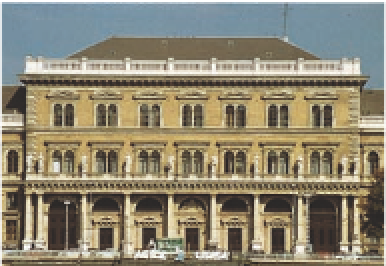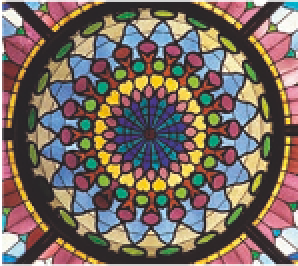Travel Reference
In-Depth Information
museum is the richest
source of art and artifacts
anywhere in the country
(see pp30-31)
.
&
Museum of
Applied Arts
The opening of this
museum was the inale
of the city's 1896 Millen-
nium Celebrations. Built
to house the Hungarian
State's sizeable collection
of art, the Secessionist building
was designed by Ödön Lechner
and Gyula Pártos. Its distinctly
Eastern style is seen in the
façade's green domes and the
glass-roofed courtyard. It features
ine arts and crafts and traditional
costumes.
d
Map D5 • IX, Üllői út 33-7
• 456 51 00 • Open 10am-6pm Tue-Sun
• Dis. access • www.imm.hu
Façade of the Corvinus University of Budapest
%
Corvinus University
of Budapest
A Neo-Renaissance masterpiece,
this University was built between
1871 and 1874 to house the city's
main customs house. Designed by
Miklós Ybl, its façade facing the
Danube is set on three levels - a
colonnade supporting a balcony,
with two rows of arched windows
facing the river. The balustrade
supports 10 allegorical igures
sculpted by August Sommer. The
building became the University of
Economics in 1951, when it was
named after Karl Marx; a statue
of Marx remains in the atrium to
this day. In 2000, it merged with
the College of Public Adminis-
tration and was renamed the
Corvinus University of Budapest.
d
Map L6 • V, Fővám tér 8 • 482 50 00
*
Great Synagogue
The largest synagogue in
Europe. Built in Byzantine style by
the Viennese architect Ludwig
Förster in 1854-9, it can house
over 3,000 people. Since 1931 it
has been home to the Jewish
Museum
(see p38)
, with relics
relating to the history of the city's
Jews. The rear courtyard has a
memorial to the Holocaust.
d
Map M3 • VII, Dohány utca 2 • 342 89
49 • Open Apr-Oct: 10am-5pm Mon-Thu,
10am-2pm Fri, Sun; Oct-Apr: 10am-3pm
Mon-Thu, 10am-2pm Fri, Sun • Adm
^
Hungarian National
Museum
The National Museum was
founded in 1802, and owes its
existence to Count Ferenc
Széchenyi
(see p31)
, who donated
his collections of books and art
to the nation. The building was
designed by Mihály Pollack and
completed in 1845. In 1848, it
was the scene of a historic event,
when Sándor Petői recited his
poem
Nemzeti Dal
(National Song)
from the steps, thus igniting the
Uprising of 1848-9. The event is
re-enacted each year. The
Stained-glass window, Applied Arts Museum
84


































































































